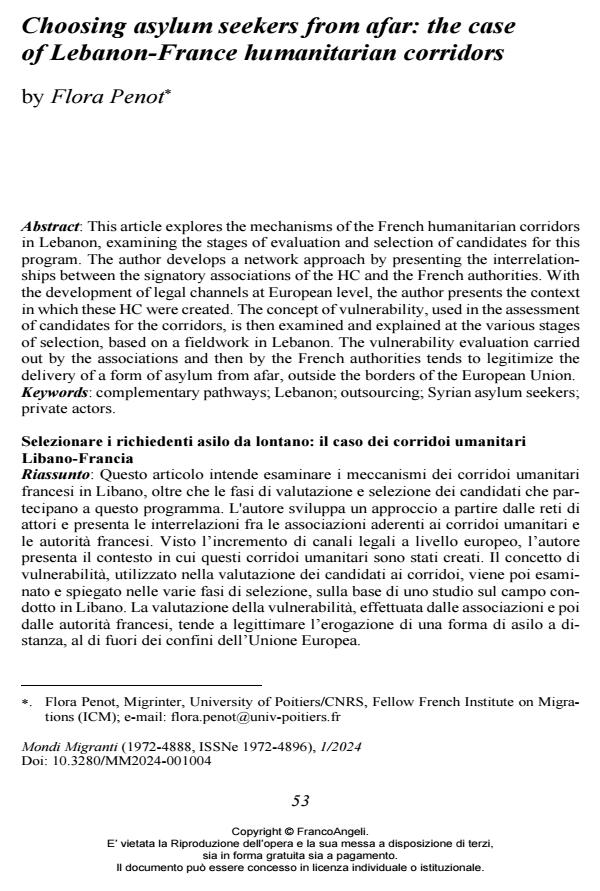Choosing asylum seekers from afar: the case of Lebanon-France humanitarian corridors
Titolo Rivista MONDI MIGRANTI
Autori/Curatori Flora Penot
Anno di pubblicazione 2024 Fascicolo 2024/1
Lingua Inglese Numero pagine 16 P. 53-68 Dimensione file 274 KB
DOI 10.3280/MM2024-001004
Il DOI è il codice a barre della proprietà intellettuale: per saperne di più
clicca qui
Qui sotto puoi vedere in anteprima la prima pagina di questo articolo.
Se questo articolo ti interessa, lo puoi acquistare (e scaricare in formato pdf) seguendo le facili indicazioni per acquistare il download credit. Acquista Download Credits per scaricare questo Articolo in formato PDF

FrancoAngeli è membro della Publishers International Linking Association, Inc (PILA)associazione indipendente e non profit per facilitare (attraverso i servizi tecnologici implementati da CrossRef.org) l’accesso degli studiosi ai contenuti digitali nelle pubblicazioni professionali e scientifiche
This article explores the mechanisms of the French humanitarian corridors in Lebanon, examining the stages of evaluation and selection of candidates for this program. The author develops a network approach by presenting the interrelation-ships between the signatory associations of the HC and the French authorities. With the development of legal channels at European level, the author presents the context in which these HC were created. The concept of vulnerability, used in the assessment of candidates for the corridors, is then examined and explained at the various stages of selection, based on a fieldwork in Lebanon. The vulnerability evaluation carried out by the associations and then by the French authorities tends to legitimize the delivery of a form of asylum from afar, outside the borders of the European Union.
Questo articolo intende esaminare i meccanismi dei corridoi umanitari francesi in Libano, oltre che le fasi di valutazione e selezione dei candidati che partecipano a questo programma. L'autore sviluppa un approccio a partire dalle reti di attori e presenta le interrelazioni fra le associazioni aderenti ai corridoi umanitari e le auto-rità francesi. Visto l’incremento di canali legali a livello europeo, l’autore presenta il contesto in cui questi corridoi umanitari sono stati creati. Il concetto di vulnerabi-lità, utilizzato nella valutazione dei candidati ai corridoi, viene poi esaminato e spiegato nelle varie fasi di selezione, sulla base di uno studio sul campo condotto in Libano. La valutazione della vulnerabilità, effettuata dalle associazioni e poi dalle autorità francesi, tende a legittimare l’erogazione di una forma di asilo a di-stanza, al di fuori dei confini dell’Unione Europea.
Parole chiave:canali d’ingresso complementari; Libano; esternalizzazione; ri-chiedenti asilo siriani; operatori private.
Flora Penot, Choosing asylum seekers from afar: the case of Lebanon-France humanitarian corridors in "MONDI MIGRANTI" 1/2024, pp 53-68, DOI: 10.3280/MM2024-001004